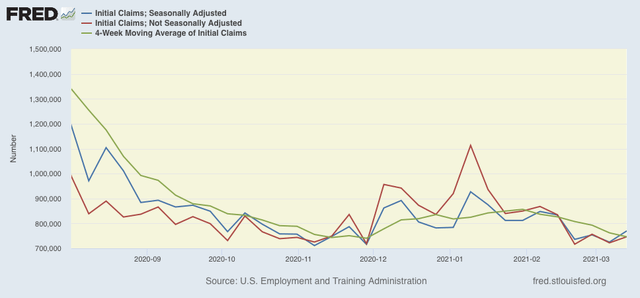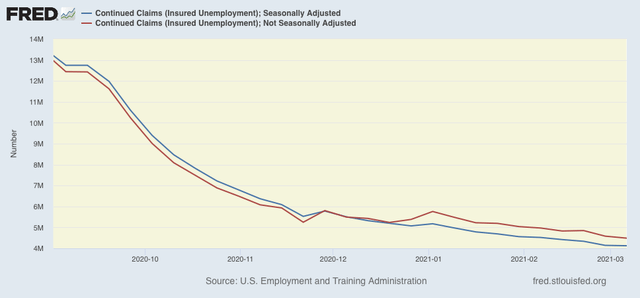Disappointing weekly increase in new jobless claims, but monthly trend improves; expect a 200,000+ number of new jobs in next Employment Report – by New Deal democrat New jobless claims are likely to the most important weekly economic data for the next 3 to 6 months. They are going to tell us whether my suspicion is correct that, as a critical mass of those vaccinated is reached, there will be a veritable surge in renewed commercial and social activities and attendant consumer spending, leading in turn to a strong rebound in monthly employment gains. More specifically, now that further COVID relief has also been passed by Congress, last week I set a few objective targets: I am looking for new claims to be under 500,000 by Memorial Day, and
Topics:
NewDealdemocrat considers the following as important: jobless claims, US EConomics, US/Global Economics
This could be interesting, too:
NewDealdemocrat writes JOLTS revisions from Yesterday’s Report
Bill Haskell writes The North American Automobile Industry Waits for Trump and the Gov. to Act
Bill Haskell writes Families Struggle Paying for Child Care While Working
Joel Eissenberg writes Time for Senate Dems to stand up against Trump/Musk
Disappointing weekly increase in new jobless claims, but monthly trend improves; expect a 200,000+ number of new jobs in next Employment Report
– by New Deal democrat
New jobless claims are likely to the most important weekly economic data for the next 3 to 6 months. They are going to tell us whether my suspicion is correct that, as a critical mass of those vaccinated is reached, there will be a veritable surge in renewed commercial and social activities and attendant consumer spending, leading in turn to a strong rebound in monthly employment gains. More specifically, now that further COVID relief has also been passed by Congress, last week I set a few objective targets: I am looking for new claims to be under 500,000 by Memorial Day, and below 400,000 by Labor Day.
This morning’s data didn’t help. On an unadjusted basis, new jobless claims rose by 424,318 to 746,796. Seasonally adjusted claims rose by 45,000 to 770,000, the highest level in 4 weeks. The 4 weeks moving average, however, declined by 16,000 to 746,250.
Here is the close up since the end of July (these numbers were in the range of 5 to 7 million at their worst in early April):

While both adjusted and unadjusted claims remain above their worst levels at the depths of the Great Recession, the outbreak-related wintertime surge has abated.
Because of the huge weekly swings caused by the scale of the pandemic, a few months ago I began posting the YoY% change in the numbers as well, since they are much less affected by scale, so there is less noise in the numbers, and the trend can be seen more clearly:
This is at levels last seen in November and December, and confirms that the recent increase in new claims has reversed. In fact, all 3 metrics are at pandemic lows of increases of 175%-225%. An important caveat is that YoY numbers are starting to be compared with the horrific initial pandemic losses of last March and April, so I will probably discontinue this metric in the next several weeks.
Meanwhile continuing claims, which historically lag initial claims typically by a few weeks to several months, made new pandemic lows yet again this week. Seasonally adjusted continuing claims declined by 18,000 to 4,124,000, while the unadjusted number declined by 95,541 to 4,486,389:

Bottom line: although this week’s number of new jobless claims was disappointing, I remain bullish that the ever-increasing pool of fully vaccinated adults – 40,000,000 as of yesterday, or 15.5% of the adult population – together with a seasonal shift from indoor to outdoor activities, is going to result in new pandemic lows well below the existing low of 711,000.
Further, the monthly change in the 4 week average of initial claims ending last week is the best we have seen since November when 264,000 jobs were added to the economy. As a result, I am looking for a similar number in the March jobs report which will be released at the beginning of April.
